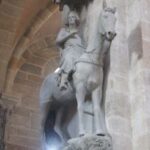Reminiscences 2024
The trip was fourteen days or so. Consequently, I broke the cruise in Bavaria before we reached Bamberg, and I promise you I’ll get you through German, Austria, and Hungary–eventually.
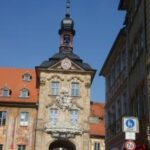 Bamberg dates from the 9th century, and its tourist appeal stems from the almost 2400 half timber homes. The highlights included an interesting stone bridge, a Rathaus (town hall) that’s on
Bamberg dates from the 9th century, and its tourist appeal stems from the almost 2400 half timber homes. The highlights included an interesting stone bridge, a Rathaus (town hall) that’s on  an island, and the residence of the prince-bishop. One interesting artistic technique evident is “fool the eye” or trompe l’oeil, which you can see pretty clearly on the side of the building here. Buried in the Cathedral are the Holy Roman Emperor Heinrich II and his wife Kunigunde, who had the cathedral built in the 11th century. It took
an island, and the residence of the prince-bishop. One interesting artistic technique evident is “fool the eye” or trompe l’oeil, which you can see pretty clearly on the side of the building here. Buried in the Cathedral are the Holy Roman Emperor Heinrich II and his wife Kunigunde, who had the cathedral built in the 11th century. It took 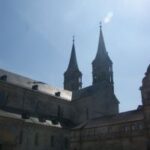 only 10 years. In addition to the sepulcher, there is a famous sculpture of the Bamberg Horseman.
only 10 years. In addition to the sepulcher, there is a famous sculpture of the Bamberg Horseman. 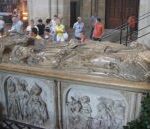
Nuremberg posed a challenge. It was another historically interesting city–both in the old days, having been founded in 1050, and of course as the center of the Nazi rallies and the Nuremberg Laws depriving Jews of citizenship. By the end of the Second World War, there were no Jews in Nuremberg, but the trials at the Palace of Justice led to the hanging of many Nazi leaders.

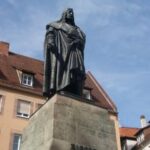 There were tours to each of these emphases. Carolyn chose the Nazi sites; having seen enough of the wartime butchery, I opted for the old city, and the home of one of its most famous citizens, Albrecht Durer. I even have a Durer coffee mug sitting on my shelf as a memento of that tour.
There were tours to each of these emphases. Carolyn chose the Nazi sites; having seen enough of the wartime butchery, I opted for the old city, and the home of one of its most famous citizens, Albrecht Durer. I even have a Durer coffee mug sitting on my shelf as a memento of that tour.
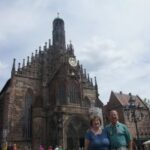
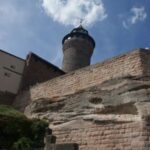 Nuremberg was an important city during the Holy Roman Empire, and the Diet frequently met in the Nuremberg Castle. Another sites, Frauenkirche, was a church built in the 14th century on the site of a synagogue destroyed after a
Nuremberg was an important city during the Holy Roman Empire, and the Diet frequently met in the Nuremberg Castle. Another sites, Frauenkirche, was a church built in the 14th century on the site of a synagogue destroyed after a 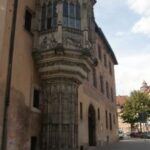
 pogrom. From 1525 until 1810 the church was Lutheran, but a parish restored it to Catholicism. There’s also a major cathedral in Nuremberg, and an unusual architectural feature, chorlein, which is a projection on the first floor of a house. It seems to be a medieval add-on.
pogrom. From 1525 until 1810 the church was Lutheran, but a parish restored it to Catholicism. There’s also a major cathedral in Nuremberg, and an unusual architectural feature, chorlein, which is a projection on the first floor of a house. It seems to be a medieval add-on.
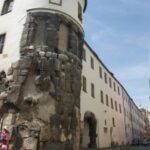
Some of the shipmates who went with Carolyn were really struck Hitler’s oratorical skills. Having seen “Triumph of the Will”, Riefenstahl’s movie of the 1934 Party rally in Nuremberg, I can believe it.
Twenty-two nautical miles from Nuremberg sits the “capital” of the Holy Roman Empire of the 
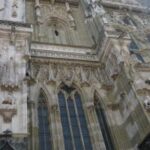 German people–Regensburg. The furthest northern point of the Danube River, it had its origins as a Roman fort, part of which still exists. From the 5th through the 13th centuries, it was the capital of Bavaria, and later the Perpetual Seat of the Empire’s Diet. In 845, 14 Bohemian princes were baptized in Regensburg; thus, the Czech lands were drawn into Roman Catholicism rather than Slavic Orthodox. Started in 1280, the Cathedral was dedicated in 1520, but has been renovated several times, including in the 19th century by
German people–Regensburg. The furthest northern point of the Danube River, it had its origins as a Roman fort, part of which still exists. From the 5th through the 13th centuries, it was the capital of Bavaria, and later the Perpetual Seat of the Empire’s Diet. In 845, 14 Bohemian princes were baptized in Regensburg; thus, the Czech lands were drawn into Roman Catholicism rather than Slavic Orthodox. Started in 1280, the Cathedral was dedicated in 1520, but has been renovated several times, including in the 19th century by 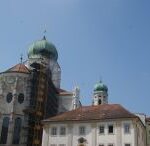
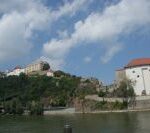 King Ludwig 1.
King Ludwig 1.
The last stop for us in Germany was Passau, where the Inn and Ilz Rivers join the Danube. It originated in Roman times, but a fire in 1662 devastated the city, which was rebuilt in the Baroque style. A 13th century fortress, Veste Oberhaus, overlooks the town; it was once the residence of the prince bishop, as was Veste Niederhaus, also a fortress protecting the city. St. 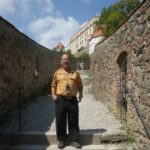
 Stephan’s Cathedral, built in 1688, had what was once the largest organ in the world, with 17,774 pipes and 233 registers.
Stephan’s Cathedral, built in 1688, had what was once the largest organ in the world, with 17,774 pipes and 233 registers.
We are about to cross the Danube into Austria,since Passau is on the border.
